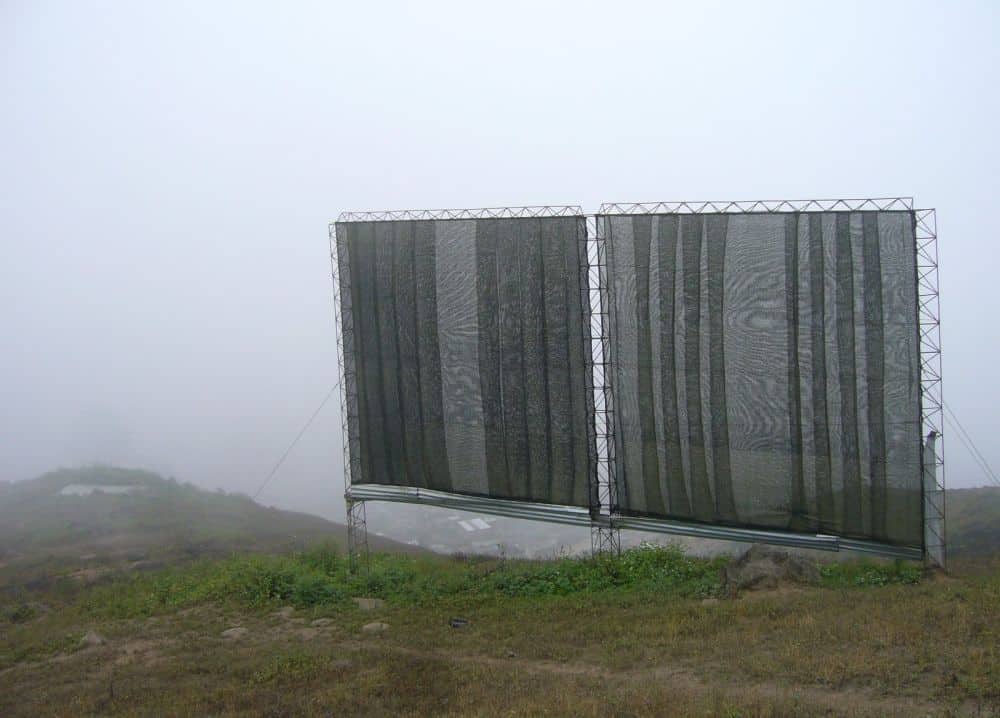
[Image above] Picture of a fog net in Lima, Peru. Fog nets provide people living in dry but foggy areas with a stable water source, but air pollution can make the collected water unsafe for use. Credit: SuSanA Secretariat, Flickr (CC BY 2.0)
More than a third of the U.S. population, from the Midwest to the East Coast, were under air quality alerts this summer because of the ongoing wildfires in Canada.
For many people, it was their first time personally experiencing the health effects of air pollution. And the effects of this exposure were immediately evident—data from the U.S. Centers for Disease Control and Prevention showed that emergency room visits for asthma increased by 17% during this period, for example.
Unfortunately, this experience with degraded air quality is likely just the prelude to many more such events. The United Nations World Meteorological Organization expects wildfire-induced air pollution to become more common in the future.
As more people around the world live in areas affected by air pollution, be it from wildfires or other natural and industrial sources, it is important to recognize that the dangers of air pollution extend beyond just health effects. For example, it affects people’s access to water as well.
In arid countries such as Peru, Bolivia, and Chile, people will harvest water through “fog catching,” i.e., by hanging up nets to catch droplets of water from the misty air. These droplets then trickle down the mesh and are collected to provide water for drinking, cooking, and washing.

Credit: BBC News, YouTube
In areas with air pollution, hazardous substances end up in the droplets of water. As such, any water harvested from the fog is not clean enough to be used untreated either for drinking or for cooking. But establishing treatment facilities to properly clean the water may not be economically feasible for these communities.
In August 2023, researchers at ETH Zurich in Switzerland and Max Planck Institute for Polymer Research in Germany published an open-access paper describing a system for simultaneously harvesting and cleaning the water collected from fog nets. The system, which requires little maintenance and only a small but regular dose of sunlight, has potential as an affordable system for communities that harvest water from polluted air.
The system consists of a metal mesh coated with anatase titanium dioxide nanoparticles embedded in a polymer matrix. The polymers ensure that droplets of water collect efficiently on the mesh and then trickle down into a container as quickly as possible before they can be blown off by the wind. The titanium dioxide acts as a chemical catalyst, breaking down the organic pollutants contained in the droplets to render them harmless.
Half an hour of sunlight is enough to activate the titanium dioxide for 24 hours. With periods of sunlight often rare in areas prone to fog, this quality is very useful.

Schematic showing the laboratory-scale fog harvesting setup used to generate contaminated fog (containing methyl orange) at an initial concentration C0, along with the fog harvesting and treatment, and measurement of the final concentration (C) of methyl orange. Φ is the fog tunnel diameter. Credit: Ghosh et al., Nature Sustainability (CC BY 4.0)
The researchers tested the system in the lab and in a small pilot plant in Zurich. It demonstrated a good fog harvesting performance (~8%) and exceptional organic pollutant reduction values of 85% and 94% when the ultraviolet index was low and high, respectively, during outdoor tests.
Additionally, the system successfully treated water contaminants such as diesel or bisphenol A, “underpinning the possibility of using such a concept in a real-world environment against a range of pollutants,” the researchers write in the paper.
In an ETH Zurich press release, first author and Max Planck scientist Ritwick Ghosh says he hopes to further advance this technology and explore marketable applications.
The open-access paper, published in Nature Sustainability, is “Photocatalytically reactive surfaces for simultaneous water harvesting and treatment” (DOI: 10.1038/s41893-023-01159-9).
Author
Lisa McDonald
CTT Categories
- Material Innovations


